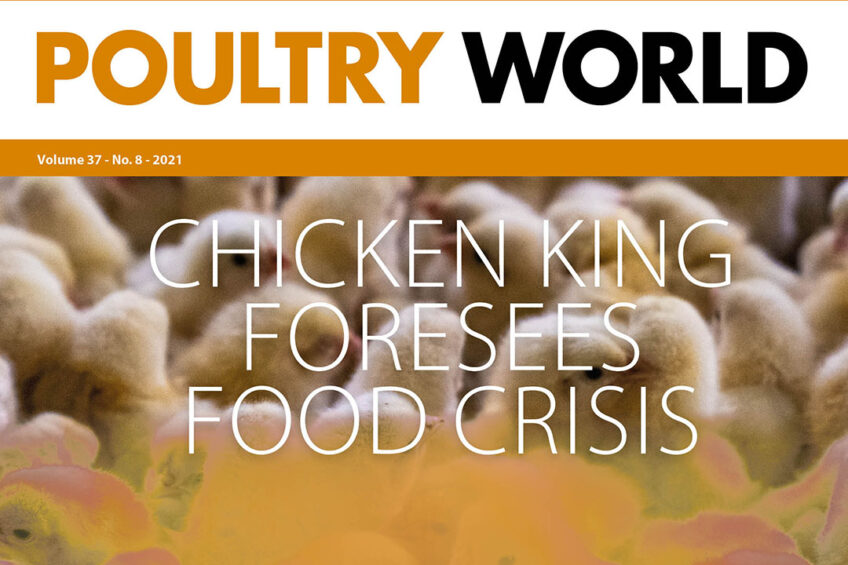Poultry World edition 8 of 2021 now online

This 8th edition of Poultry World highlights concerns from the owner of one of the largest chicken and food producers, the 2 Sisters Food Group, regarding Britain’s food crisis. The edition investigates ethical concerns with in-ovo gender determination, the dynamics of cage-free housing, the role and potential of plant-based additives and organic minerals, as well as the importance of good feather cover.
View this issue of Poultry World
British ‘chicken king’ warns of a serious food crisis
Founder, owner and president of one of the largest chicken and food producers, the 2 Sisters Food Group, Ranjit Singh Boparan, says Great Britain may be facing its worst food crisis in 75 years as chicken and turkey shortages are noticeable. But, he warns, worse is yet to come.
Ethical concerns remain with in-ovo gender determination
The technology of in-ovo gender determination of incubated eggs, which can provide a beneficial substitute for the large-scale culling of male chicks in layer hen production, raises ethical concerns relating to the sensitivity of the embryo and the use of screened-out eggs.

Organic minerals promote broiler leg quality
Minerals play an important role in the development of leg bones of poultry, and leg bone health is important for the health and welfare of the birds as well as for processing yields. Wageningen University and Research takes a closer look at the effect of organic macro minerals on bird leg health.

Cage-free US egg industry: sooner rather than later
In 2018, the Farm Animal Confinement Initiative was approved and so, from the end of 2021, laying hens, nursing sows and veal calves in the state must be housed in systems that “comply with specific standards for freedom of movement, cage-free design and minimum floor space”. However, the law has reach far outside of California.

Alpha-monolaurin boosts immune response of IB-vaccinated broilers
A new study reports that alpha-monolaurin stimulates the immune response of broilers after vaccination against infectious bronchitis and may therefore result in better protection against future infections.

Antimicrobial stewardship needs constant attention
According to a UK poultry vet, further studies are needed on the impact of antibiotic reduction strategies and how they affect the resistance of important organisms. He asks why fluroquinolone resistance still exists (despite not having been used in broiler meat production for about 8 years) and how we can modify our reduction plans.
View this issue of Poultry World
Understanding the dynamics of cage-free housing
It is imperative to have a proper layer health and welfare plan with the transition to more cage-free and outdoor access systems. But, how can we best manage and care for birds in these housing systems?

A good start to achieve a strong finish
Successful poultry producers rely on a solid start and so integrating nutrition, farm management and gut health from the word ‘go’ can optimise chick performance and potential.

Importance of feather cover in broilers
Feather growth begins at day 5 of incubation and by 40 days of age, broilers will have about 50 g of feathers. A bird’s feathers play and important role in protecting the skin and underlying tissue.

Combating Spotty Liver Disease naturally
Although vaccines are in development to fight Spotty Liver Disease, none are commercially available yet. Can plant-based nutritional solutions support layer performance when faced with this disease?

Thoughts on future-ready layer operations
Producers looking to transition from caged to cage-free egg production may have considered a combi system, often said to be an ideal solution for poultry houses. What are some of the misconceptions that could lead to buyer’s remorse?

Plant-based additives to mitigate effects of harmful gases
There is an increasing urgency to reduce greenhouse gas emissions, particularly from the agriculture sector being the third-largest contributor. Plant-based feed additives have proven to reduce ammonia emissions.

Study reveals main risk factors for Newcastle disease in Brazil
A study in Brazil has highlighted several risk factors for the spread of Newcastle Disease from backyard farms to commercial producers.
To access the magazine section, where you will find the 8th edition of Poultry World 2021 as well as other magazines from specialists in the agriculture industry, simply register for free.












